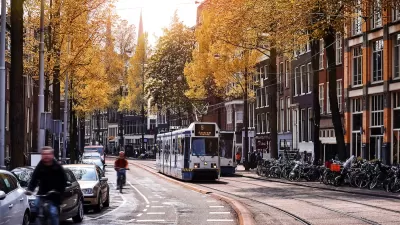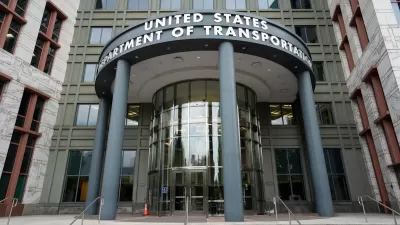Republicans appear set to make significant political inroads in Congress this November, perhaps taking control of the U.S. House of Representatives and knocking on the door of majority control of the U.S. Senate. Their success will be in no small part due to the so-called Tea Parties, a grassroots political movement reacting to the perceived excess of the federal government. Planners should take note. While the Tea Party Movement is largely a national and statewide, its effects may well be felt on the local and regional level as well.
Republicans appear set to make significant political inroads in Congress this November, perhaps taking control of the U.S. House of Representatives and knocking on the door of majority control of the U.S. Senate. Their success will be in no small part due to the so-called Tea Parties, a grassroots political movement reacting to the perceived excess of the federal government. Planners should take note. While the Tea Party Movement is largely a national and statewide, its effects may well be felt on the local and regional level as well.
On the surface, the Tea Parties indeed appear to be nationally focused. Detailed survey data analyzed by pollsters Scott Rasmussen and Doug Schoen in their new book Mad as Hell: How the Tea Party Movement is Fundamentally Remaking Our Two-Party System, observe that three issues galvanize the upstart political movement: the burgeoning national debt, uncontrolled federal spending, and federal overreach in the economy and into state sovereignty. This fiscal conservatism crosses enough partisan boundaries to make the Tea Party the nation's largest political party if it were formalized (followed by the Democratic Party and then the Republican Party in a distant third.) While 60 percent self-identify as Republicans, a hefty plurality are independents and (Blue Dog) Democrats.
Much of the political support for this fiscal conservatism is populist in nature, creating a mixed bag for planning. The practice of urban planning is fundamentally populist: Citizens serve in decision making capacities on planning commissions; these planning commissions report to elected officials; and professional planners provide expertise, advice, and counsel to both. Thus, in theory at least, the Tea Party populism can be a boon for citizen activism. Moreover, the substance of Tea Party concerns suggests that some of this activism can be channeled into community activism.
On the other hand, the political motivations of Tea Partiers are fiscally conservatives. Tea Partiers engaged in local politics are likely to bring the same requirements for accountability, balance, cost effectiveness, and transparency to local government that they are demanding at the federal level. Local activists spurred to political engagement will be less tolerant of local government excesses such as the debacle in New London, Connecticut (Kelo v New London) that spurred a national backlash against eminent domain's use for economic development, the emerging procurement disaster drowning Houston's light rail initiatives, or the rosy-scenario decisionmaking (also called "optimism bias") that increasingly jeopardizes regional transit projects such as FasTrac in Denver.
Dismissing the Tea Party movement as narrowly focused on national and federal policy likely underestimates its strength and breadth. While the Tea Parties are not formal or nationally organized political parties, their supporters will probably coalesce into voting blocks that are more consistent and focused on specific policy issues. After all, Tea Partiers vote in local elections as well as national ones, and many of the activists will be spurred to become more involved in city, county, and regional policymaking.
The key to harnessing this activism productively is to recognize the fiscally conservative and populist nature of the movement and avoid aloof attitudes or professional posturing that remotely hints at elitism or disrespect for citizen input. Fortunately, in the United States, the citizen-driven nature of planning is well suited to adapt to the demands of this movement.

Study: Maui’s Plan to Convert Vacation Rentals to Long-Term Housing Could Cause Nearly $1 Billion Economic Loss
The plan would reduce visitor accommodation by 25,% resulting in 1,900 jobs lost.

Placekeeping: Setting a New Precedent for City Planners
How a preservation-based approach to redevelopment and urban design can prevent displacement and honor legacy communities.

Using Old Oil and Gas Wells for Green Energy Storage
Penn State researchers have found that repurposing abandoned oil and gas wells for geothermal-assisted compressed-air energy storage can boost efficiency, reduce environmental risks, and support clean energy and job transitions.

Homeowners Blame PG&E for Delays in ADU Permits
The utility says it has dramatically reduced its backlog, but applicants say they still face months-long delays for approvals for new electrical work.

Rethinking Wildfire Defense: How a Landscape Approach Can Protect Neighborhoods
Post-fire analysis of the Eaton Fire reveals that a landscape approach — including fire-resistant vegetation, home hardening, and strategic planning — can help reduce wildfire risk, challenging assumptions that trees and plants are primary fire hazards.

Scientists Studying Artificial Reefs as Flood Mitigation in Great Lakes
Artificial reefs could offer a ‘softer’ flood management and erosion solution that doesn’t disrupt the flow of sediment.
Urban Design for Planners 1: Software Tools
This six-course series explores essential urban design concepts using open source software and equips planners with the tools they need to participate fully in the urban design process.
Planning for Universal Design
Learn the tools for implementing Universal Design in planning regulations.
Borough of Carlisle
Caltrans
Heyer Gruel & Associates PA
Institute for Housing and Urban Development Studies (IHS)
City of Grandview
Harvard GSD Executive Education
Salt Lake City
NYU Wagner Graduate School of Public Service
City of Cambridge, Maryland






























